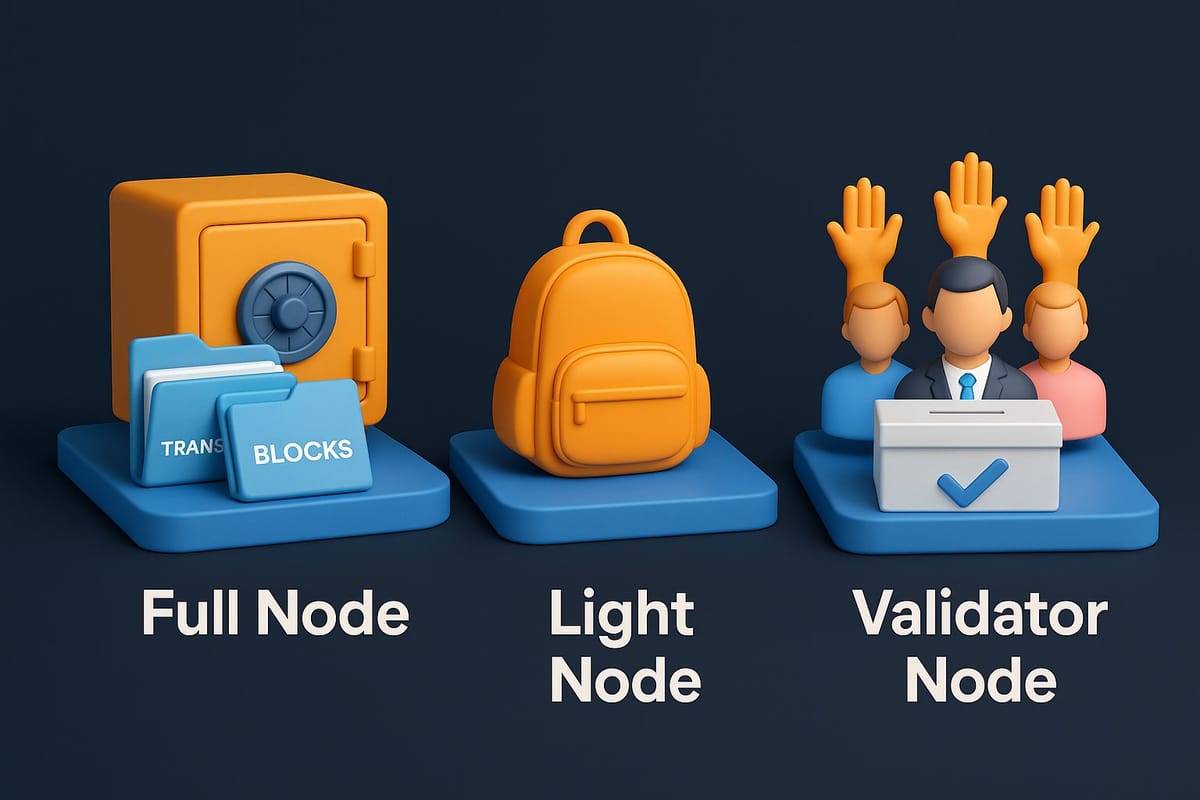Web3 Validators: Roles, Requirements & Consensus Mechanism Differences

As Web3 evolves, validators have become the cornerstone of trust in decentralized networks. Whether securing blockchains, approving transactions, or keeping the system fair, validators are the guardians of consensus.
In this article, we explore:
- How validation works across consensus mechanisms
- What you need to become a validator
- What validators actually do
- Unique behaviors and responsibilities under each consensus type
What Is a Validator in Web3?
A validator is a node or participant in a blockchain that helps verify and confirm transactions to keep the ledger accurate and secure. In most systems, validators also help propose new blocks and reach consensus with others.
Core Functions of Validators:
- Verify transactions: Check that transfers are signed, balances are valid, and smart contracts behave properly.
- Propose blocks: Some validators are chosen to build new blocks of transactions.
- Reach consensus: Participate in the protocol’s decision-making to confirm valid blocks.
- Earn rewards: Validators are incentivized with tokens for honest participation.
- Maintain uptime: Being online and responsive is critical for most consensus mechanisms.
Validator Properties by Consensus Mechanism
Each blockchain uses a different consensus mechanism, and validators behave differently depending on which one is used. Let’s explore how.
1. Proof of Work (PoW)
Used by: Bitcoin, Litecoin
Validator Type: Miner (not called "validator" technically, but functionally equivalent)
Functions:
- Solve a cryptographic puzzle (Proof-of-Work)
- Select and propose a block of transactions
- Validate previous block’s chain integrity
Requirements:
- ASIC or GPU hardware
- High electricity availability
- Mining software and network connectivity
Peculiarities:
- Competitive: Only the first miner to solve the puzzle adds the block
- High energy use
- Validation relies on computation, not identity or stake
2. Proof of Stake (PoS)
Used by: Ethereum 2.0, Cardano
Validator Type: Staker
Functions:
- Validate and attest to new blocks
- Occasionally propose new blocks (randomly assigned)
- Participate in finalizing transactions
Requirements:
- Minimum stake (e.g., 32 ETH on Ethereum)
- Reliable internet connection and uptime
- Validator client software
Peculiarities:
- Risk of slashing for malicious behavior or downtime
- Deterministic block proposal based on stake
- Energy-efficient and scalable
3. Delegated Proof of Stake (DPoS)
Used by: EOS, TRON
Validator Type: Block producer (voted in by the community)
Functions:
- Create and validate blocks in assigned time slots
- Maintain high-performance servers
- Provide transparency reports to voters
Requirements:
- Win community votes (popularity-based)
- Enterprise-grade hardware
- Commitment to uptime and performance
Peculiarities:
- Fewer validators (e.g., 21 in EOS)
- Faster block times, but lower decentralization
- Validator reputation and community trust are crucial
4. Proof of Authority (PoA)
Used by: VeChain, private Ethereum networks
Validator Type: Trusted identity nodes
Functions:
- Validate and sign blocks
- Enforce network rules and compliance
- Act as public, accountable entities
Requirements:
- Pre-approved identity
- Institutional-level infrastructure
- Governance or organizational backing
Peculiarities:
- Validators are public and known
- Fast block confirmation, suited for enterprise or private use
- Not decentralized, but highly efficient
5. Practical Byzantine Fault Tolerance (PBFT)
Used by: Hyperledger Fabric
Validator Type: Committee nodes (known participants)
Functions:
- Exchange messages to reach consensus
- Validate transaction logic and state
- Participate in pre-prepare, prepare, and commit phases
Requirements:
- Permissioned access (enterprise or government nodes)
- Trusted identity and network reputation
- Secure communication channel
Peculiarities:
- Strong finality: blocks are final once added
- Low tolerance for faults (maximum one-third malicious)
- Fast but limited to private or consortium environments
Comparing Validators Across Consensus Models
| Property / Role | PoW | PoS | DPoS | PoA | PBFT |
|---|---|---|---|---|---|
| Open to public | Yes | Yes | Yes (voting) | No | No |
| Rewards | Block reward | Block reward + fees | Block reward | Fixed or custom | Custom or none |
| Penalties | Energy cost | Slashing | Reputation loss | Removal | Reputation |
| Block proposal | Competition | Random + stake | Rotational | Rotational | Rotational |
| Finality speed | Probabilistic | Fast | Fast | Very Fast | Immediate |
| Decentralization level | High | High | Medium | Low | Low |
| Resource intensity | High | Low | Medium | Low | Medium |
How to Choose Where to Validate
Here are some factors to consider when choosing where to participate:
- Do you have technical skills or enterprise-grade infrastructure?
Consider PoS, DPoS, or PoA networks. - Are you looking for decentralization and fairness?
PoS and PoW offer the most open environments. - Are you part of a business consortium or private network?
PBFT or PoA may suit you best. - Do you want passive income with minimal risk?
Look into pooled staking in PoS systems.
Validators are the unsung heroes of blockchain consensus. They secure networks, process transactions, and earn rewards , but their role varies drastically depending on the system. Whether you're a tech-savvy individual, an organization, or an enterprise, there's a way to participate in validation that suits your goals.
By understanding how consensus models shape validator behavior, you’ll be better equipped to join the decentralized future of Web3.
If you have any questions with regards to setting up a Validator node that has not been fully explored in this article, feel free to leave a comment and I would respond as soon as possible.



Comments ()